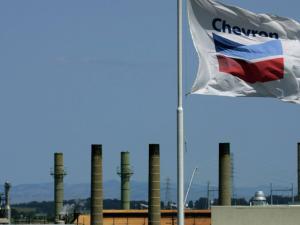Oil refinery affecting air quality - study
August 27 2013 at 03:30pm
By Melanie Gosling

AP
Chevron's refinery in Richmond, California, which processes 250 000 barrels of crude oil a day, is allowed to emit only 7.21 tons of sulphur dioxide a day.
Related Stories
Cape Town - Chevron’s oil refinery in California is twice as big as its refinery in Table View, Cape Town, yet the US operation produces fewer toxic emissions because California has stricter air pollution laws.
Now Table View residents are calling on the city to ensure that Chevron’s emissions in Cape Town are also capped at a lower level because there is evidence that the plant’s emissions are affecting air quality and the health of people living in neighbouring areas.
A UCT study has shown that asthma among school children near Chevron’s Table View refinery is nearly nine times higher than that of school children in other Cape Town areas.
The Table View Residents’ Association was responding to a call from the city council for public comment on Chevron’s application to renew its atmospheric emission licence. All refineries and other air-polluting industries in the country have to renew their emission licences – often called “licences to pollute” – in terms of the Air Quality Act, which had updated the country’s air pollution laws.
Chevron said in its application to the city council that it wants to increase the number of barrels it puts through its Table View refinery from 100 000 a day to 115 000, and is asking for permission to emit 22 tons of sulphur dioxide a day.
However, Chevron’s refinery in Richmond, California, which processes 250 000 barrels of crude oil a day, is allowed to emit only 7.21 tons of sulphur dioxide a day.
The association said the city must limit Chevron’s daily sulphur dioxide emissions to 8.6 tons a day.
While it did not say that Chevron in Cape Town had to comply with stricter standards in the US for sulphur dioxide emissions, it had made the comparison so the city could see what was possible for Chevron to achieve internationally by using the best available technology to reduce toxic emissions.
Chevron Corporation, a multinational company with refineries around the world, had made a profit of $6.2 billion (R62bn) in its most recent financial quarter. It therefore had “ample resources” to pay for installing modern technology at the Table View refinery to bring down toxic emissions.
The association told the city that allowing Chevron to emit 22 tons of sulphur dioxide daily would mean “an unacceptable impact on the health of residents living in the vicinity of the refinery” and would conflict with the city’s duty to protect and enhance air quality.
It said although reports for 2010 to 2012 showed that Chevron’s monthly averages of daily sulpher dioxide emissions were below 22 tons a day, these reports did not show whether there were days when the 22 tons had been exceeded.
This was important because the US Environmental Protection Agency said scientific evidence linked respiratory illness to short-term exposures of sulphur dioxide ranging from 24 hours to just five minutes. Chevron needed to provide this information.
Nitrous oxide levels should be limited to 9.2 tons a day.
Legal Resources Centre lawyer Angel Andrews said they had asked the city and Chevron for a meeting to discuss their concerns, without response.
Chevron spokeswoman Suzanne Pullinger said concerns raised by the public would be “considered and responded to by Chevron” during the public participation process. - Cape Times
|

